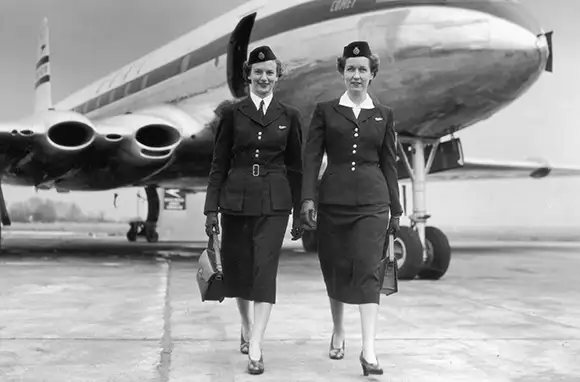
A colleague emailed me a while back about a possible interview with a reporter looking for background on the golden age of air travel, which the reporter pegged as the 1950s and ’60s. I was a good choice for the interview because I actually flew during that period. Although the interview never happened, the subject piqued my interest enough to gather some thoughts. My basic conclusion is that I can’t identify a single golden age; instead, I think air travel passed through six golden ages.
Image Gallery
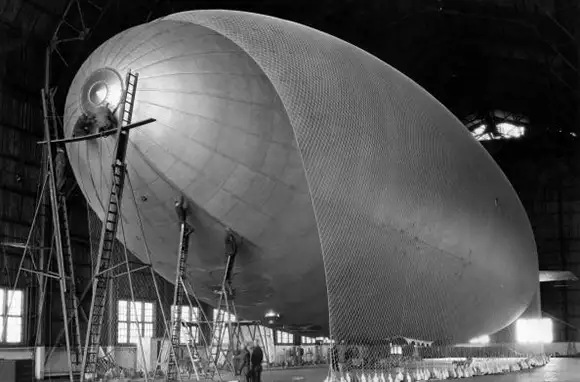
1932â1941: Flying Palaces
The first golden age started when new seaplane and airship giants began flying across the Atlantic and the Pacific and to South America. Interiors featured individual passenger chairs, separate dining areas, lounges, and, in some configurations, individual cabins and full-size beds, all with lots of personal service. The airships were far bigger than the largest contemporary land-based planes because they did not need long paved runways. The Graf Zeppelin and larger Hindenburg provided similarly elegant airship service from Germany to South America starting in 1932 and to the U.S. starting in 1936, ending in early 1937 with the Lakehurst disaster. Airships and flying boats disappeared almost immediately after World War II as soon as the much faster and more economical land-transport DC4s and Constellations became available.
Fares were extremely high—higher than Concorde fares, adjusted for inflation—and the clientele was limited to the very wealthy and government VIPs. The flights were slow and unreliable, and many early trans-ocean flights operated by day only and landed at intermediate points (Newfoundland, Ireland, or the Pacific Islands) for overnight stops.

1932â1941: Flying Palaces
The first golden age started when new seaplane and airship giants began flying across the Atlantic and the Pacific and to South America. Interiors featured individual passenger chairs, separate dining areas, lounges, and, in some configurations, individual cabins and full-size beds, all with lots of personal service. The airships were far bigger than the largest contemporary land-based planes because they did not need long paved runways. The Graf Zeppelin and larger Hindenburg provided similarly elegant airship service from Germany to South America starting in 1932 and to the U.S. starting in 1936, ending in early 1937 with the Lakehurst disaster. Airships and flying boats disappeared almost immediately after World War II as soon as the much faster and more economical land-transport DC4s and Constellations became available.
Fares were extremely high—higher than Concorde fares, adjusted for inflation—and the clientele was limited to the very wealthy and government VIPs. The flights were slow and unreliable, and many early trans-ocean flights operated by day only and landed at intermediate points (Newfoundland, Ireland, or the Pacific Islands) for overnight stops.
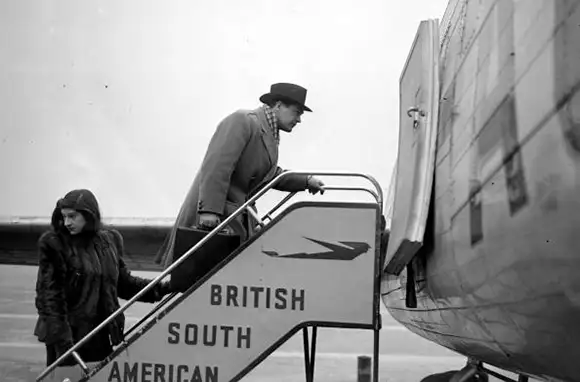
Late 1940sâEarly 1950s: Flying Comes of Age
The first generation of planes designed for serious commercial air travel—Constellations and DC6s for long hauls, Convairs and Martins for shorter trips—arrived on the scene in big numbers, along with a few Boeing Stratocruisers, the ultimate piston transports. Flights were all one class and quite comfortable—about equivalent to today's international premium economy—and most travelers dressed up to fly. It was all very middle class and genteel, with mostly business travelers along with a smattering of students and a few well-off or adventurous tourists. Even though airlines quickly captured the dominant position in long-haul business travel from railroads and steamships, overall traffic was still far enough below today's levels, which allowed for lots of personal service. And although we didn't know it then, we enjoyed blessed freedom from the increasingly intrusive security hassles that were to come.
But piston planes were noisy inside; some vibrated like you wouldn't believe. They bounced around in turbulence, and they were far less mechanically reliable—especially the Stratocruisers—than future jets. Navigation systems, landing aids, and weather-predictive abilities were pretty primitive. Winter conditions routinely forced lots of flights to be canceled. Airports were also primitive: no jetways, no baggage conveyors. Reservations systems were based on paper chits filled out by hand. To claim your baggage, you had to wait for a "skycap" to wheel out a cartload of bags, place them on a counter, and hand your bag to you individually when you pointed to it and presented a claim check and a tip.
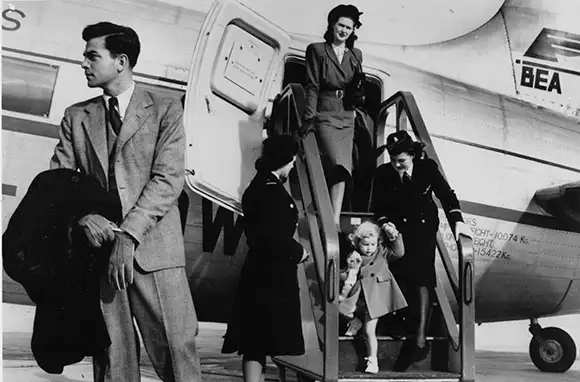
1958âEarly 1960s: The Jet Revolution
Lots of old-timers would likely cite this period as the true golden age of air travel. From the beginning, the new 707s, DC8s, 880s, Comet IVs, and later models were bigger, faster, quieter, smoother, roomier, and far more reliable than the piston planes they displaced, and conditions were opulent in the front first-class cabin and acceptable in the rear. Those glamorous and nostalgic pictures—with serving carts, freshly carved roasts, and bottomless champagne—are almost always depicting first-class cabins in these early jet days. Even though coach seats were tight, load factors in the 60 percent range meant lots of empty middle seats on most flights.
First-generation range limitations eased when fan-jet versions arrived in the early 1960s, permitting reliable nonstop transatlantic flights, even from the West Coast. Traffic grew rapidly and attracted a far more diverse market. Meanwhile, although not many took notice, in 1959, tiny PSA bought a small fleet of state-of-the-art turboprop Electras and challenged the giants in what was then the nation's busiest air-travel market, Northern to Southern California. Its low intrastate fares (regulated only by a compliant state agency) and efficient operations provided the blueprint for Southwest's later emergence as a game changer.
However, interstate and international airfares were still regulated, and various rules, both here and overseas, stifled innovation and prevented the industry from offering really low-priced air travel.
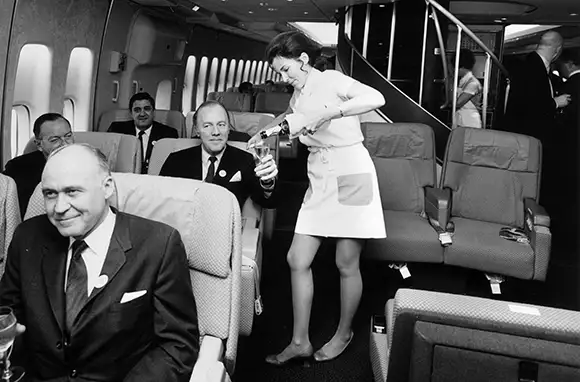
Early 1970s: Jumbo Planes, Jumbo Discounts
First the 747s, starting in 1970, then DC10s and L1011s provided substantial improvements in both the first-class and economy cabins, with more spacious seats and more elaborate in-flight services and facilities. One airline even had a piano bar in coach. Although most fares were still regulated, it became easier for ordinary travelers to find low-fare options. Easier access to charter flights and "bucket shop" discounters offered big reductions for overseas travel, and federally unregulated intrastate lines in California and Texas were inventing what would become the basic domestic low-cost business model.
But hijackings of flights—as many as 82 in 1969—led to universal airport-security screenings, with all the attendant hassles. At first, the big worry was people who demanded to be flown to Havana; terrorists came later. Once the screenings started, however, it only got worse. Also, after a few years, all the lines downgraded economy service and seating levels in their jumbos to no better than the older planes.
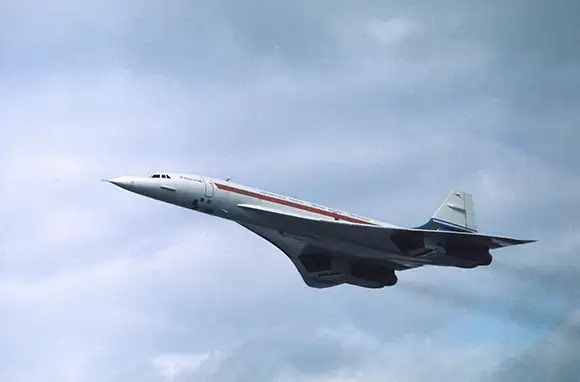
1976â1978: Ultimate Flights for the Few, Low Fares for the Many
The supersonic Concorde started flying to London and Paris from Washington, D.C., in January 1976 and from New York in November 1977. For anyone lucky or wealthy enough to get on, the Concorde was the pinnacle of flight. There was something very civilized about an 11 a.m. departure from JFK and, after an extended lavish lunch and a little more than three hours in the air, arriving in London or Paris early enough for a late supper. I did it twice (as lucky rather than wealthy), paying less than 10 percent of the regular fare (a long story). Meanwhile, although fares were still regulated, Freddie Laker managed to launch his revolutionary Skytrain in 1977, offering charter-level transatlantic fares to anyone who wanted to go. The giant airlines quickly matched. The low-fare genie was out of the bottle.
But noise, range limitations, and economics excluded the Concorde from many potential routes. High fuel prices and concerns for the environment killed off what looked like a far superior supersonic design from Boeing, and accelerated by the Charles de Gaulle Concorde crash, non-military supersonic flight disappeared. Skytrain didn't survive the recession of the early '80s, but fortunately, Laker's low-fare model lives on.
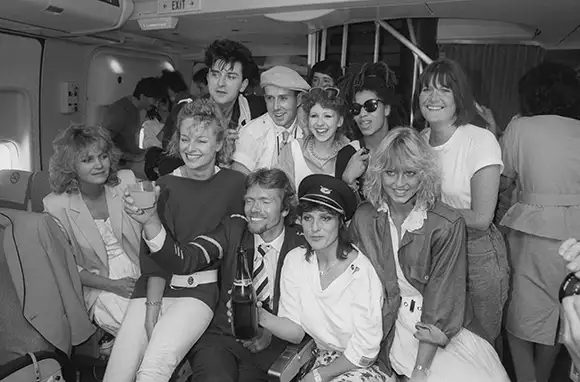
1978â1980s: Deregulation, Finally
The Airline Deregulation Act of 1978 formally ended U.S. government oversight of where domestic airlines could fly and how much they could charge. The existing giant airlines reorganized their routes and evolved their hubbing systems, and dozens of new low-fare airlines started flying. The environment was heady, with probably more innovation than at any other period. Southwest expanded and prospered as the nation's largest low-fare line. Although slower, de facto deregulation of international flights also began, with increasingly liberal rules even in countries still intent on protecting their national airlines.
But the managers of both the giant airlines and the start-up ventures didn't really understand a deregulated marketplace very well, and many failed.
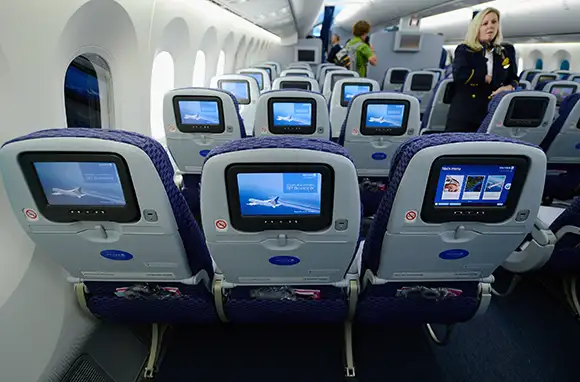
Now: The Best of Times, the Worst of Times
Travelers in the front cabins of long-haul international flights never had it so good. Flat-bed seats are becoming the de facto standard in business class—airlines without them are struggling to catch up—and where first class is still offered, seats are becoming suites. Meal and beverage service is as lavish as it was on those flying palaces, and cabin service is attentive. Ultra long-range planes permit nonstops from just about any city in the world to just about any other city.
But fares for those extravagant front-cabin seats are astronomical. And economy class keeps getting worse, not better. Travelers in the rear cabins face tightening seats, fees for almost everything, crowded planes, and, overall, a hostile environment. The front cabins on domestic flights are filled mainly with frequent flyers and business travelers who get upgraded from economy, and beyond the big seat, service isn't a lot better. The only upside is low economy fares—at least on competitive routes—but that's the way the market wants it.
You Might Also Like:
We hand-pick everything we recommend and select items through testing and reviews. Some products are sent to us free of charge with no incentive to offer a favorable review. We offer our unbiased opinions and do not accept compensation to review products. All items are in stock and prices are accurate at the time of publication. If you buy something through our links, we may earn a commission.
Top Fares From
Today's Top Travel Deals
Brought to you by ShermansTravel
Shop and Save with Country Inns...
Patricia Magaña
 Hotel & Lodging Deals
Hotel & Lodging Deals
$229 -- Chicago: Discounted Rates and...
Francesca Miele
 Hotel & Lodging Deals
$229+
Hotel & Lodging Deals
$229+
$188 -- Honolulu: Save on Oceanview...
Abigail Lamay
 Hotel & Lodging Deals
$188+
Hotel & Lodging Deals
$188+



